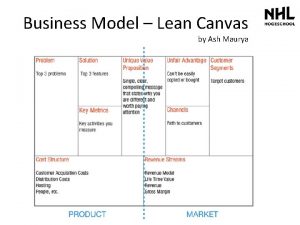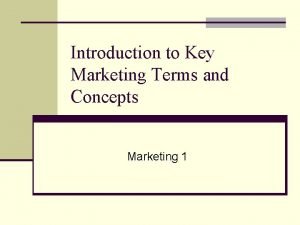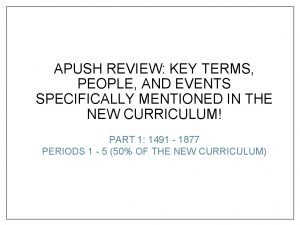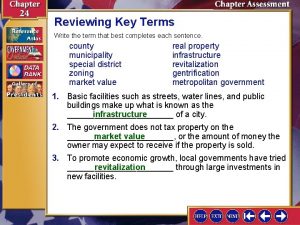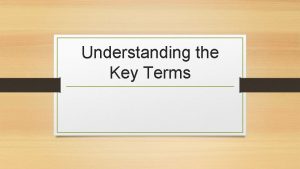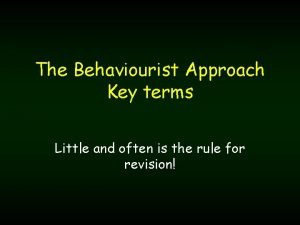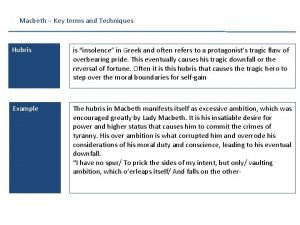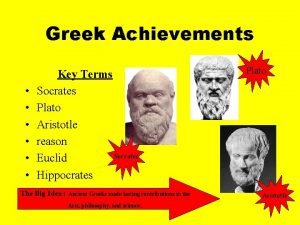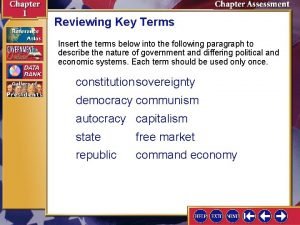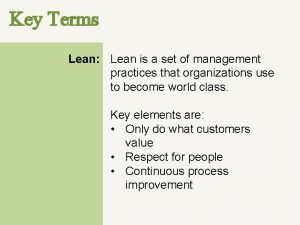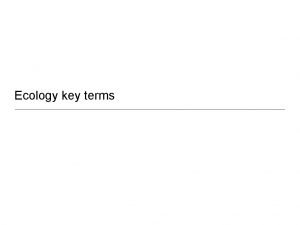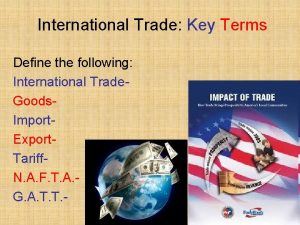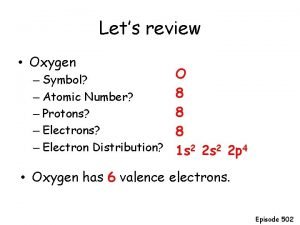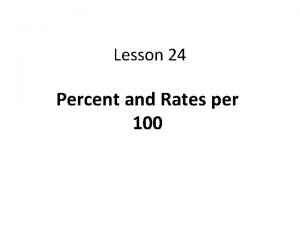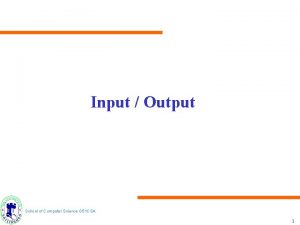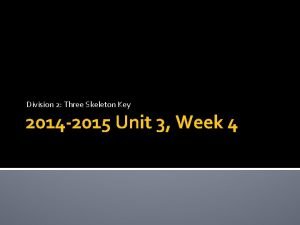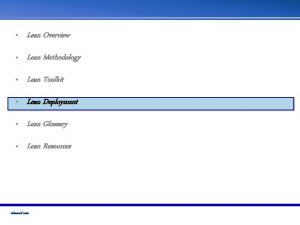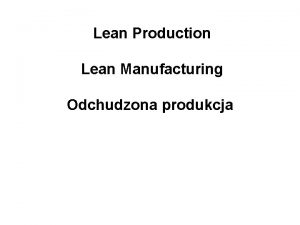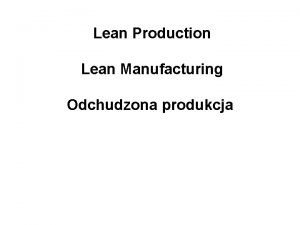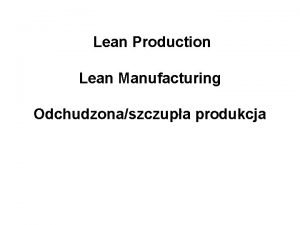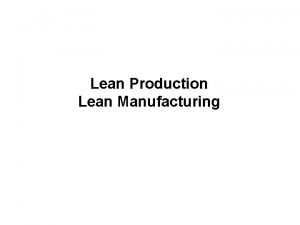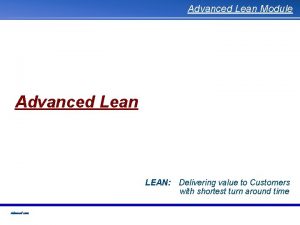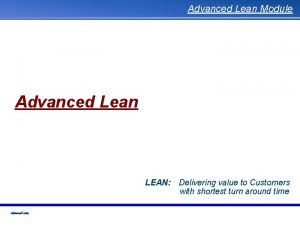Key Terms Lean Lean is a set of
























































- Slides: 56

Key Terms Lean: Lean is a set of management practices that organizations use to become world class. Key elements are: • Only do what customers value • Respect for people • Continuous process improvement

Kaizen Mindset Kaizen means “change for the better” (Japanese: kai = drive out the bad; zen = good). • Aspire to excellence – work toward a vision of how things should be. • Share in the responsibility for improving the work. • Be hard on the process, and easy on the people. • Challenge current thinking. • Think like a scientist; base conclusions on facts and data. • To get the facts, go to where the work happens. • Seek ideas from many people. • Use creativity first, not capital. • Imagine ways to make it happen instead of thinking why it can’t be done. • Make progress every day; 50% improvement is better than waiting for perfection. • Stay focused on the customer. • Have the courage to fail. Fail small and fail fast. Learn quickly.

Methodology for problem-solving Grasp the situation Initial perception of the problem 1. Clarify the problem vs the ideal state 2. Break down the problem 3. Set improvement target 4. Analyze root cause Plan 5. Develop countermeasure Do 6. Test countermeasure Check 7. Monitor the process & results Act 8. Follow up with appropriate action

PDCA Take Action: • Adopt • Adapt • Abandon Evaluate: • Check process • Check results Create Countermeasures • Develop a hypothesis • Design an experiment & measurement plan Implement: • Inform • Train • Test process

A 3 tool Title 1. Background 17” Name & Date 5. Proposal 2. Current State 6. Action Plan 11” 3. Improvement Target 4. Root Cause Analysis 7. Follow Up

Methodology for problem-solving Grasp the situation Initial perception of the problem 1. Clarify the problem vs the ideal state

Clarify the problem Identify the ideal situation, the current situation, and the gap between them: • Go see – observe the situation first hand • Talk with the people involved to find out where the problem occurs • Find out why the problem is a problem – what is happening vs. what should happen?

Kaizen Mindset Kaizen means “change for the better” • Aspire to excellence – work toward a vision of how things should be.

A 3 tool Title 1. Background 2. Current State 3. Improvement Target 4. Root Cause Analysis Name & Date 5. Proposal q Summarizes what you are talking about q Highlights why anyone 6. Action Plan should care q Defines a gap between the way things are and the way things should be 7. Follow Up q Is concisely written

Methodology for problem-solving Grasp the situation Initial perception of the problem 1. Clarify the problem vs the ideal state 2. Break down the problem

Kaizen Mindset Kaizen means “change for the better” • Be hard on the process, and easy on the people.

Break down the problem 1. 2. 3. 4. Get the “Voice of the Customer” Observe the actual process Document the process Collect and analyze facts and data

Key Terms Customer: The direct recipient of our product or service Process partner: Those who are both upstream and downstream in the process Stakeholder: Those who have an interest in or are impacted by how we serve the customer Customer What your customers want, need, requirements: and expect

Value is defined by the customer Quality: • • Does it work? Look and feel right? Meet my service standards? Was I treated fairly? Is it safe? Convenient? Right the first time? My needs are… Cost: • At what expense? Delivery: • How long does it take? • Was it received on time?

Gathering customer requirements 1. Identify your customer (and key stakeholders) 2. Ask what is most important to them in your product or service – Seek to understand why it is important – Ask clarifying questions to get specifics (eg: how many minutes before it becomes “late? ” 3. Ask them to prioritize what is most important 4. Ask how you are doing now

Key terms Value: Qualities of a product or service that are required by the customer Value-added Process steps that transform the work: product or service to meet customer requirements Waste: Any action that consumes resources but does not add value

Key terms Process: A repeatable series of activities performed in order to produce a specific product or service Input Step 1 Step 2 Step 3 Step 4 Step 5 Product or Service Customer Process walk: Observing a process in order to learn about the current state and results of a process. Also known as 3 actuals.

Kaizen Mindset Kaizen means “change for the better” • To get the facts, go to where the work happens.

Seek to understand the process • What is this process? What triggers it to begin? • What is the demand? How many do you produce? • How long does this step/whole process take? • How long does the product wait for the next step? • How often does this occur? • How often do you have defects? What kind?

Kaizen Mindset Kaizen means “change for the better” • Think like a scientist; base conclusions on facts and data. • Seek ideas from many people.

Red flags for data gathering When you hear: • "always" • "never" • variability • Be curious and gather data to quantify!

A 3 tool Title 1. Background 2. Current State 3. Improvement Target 4. Root Cause Analysis q Describes what is happening now q Shows the current process, Name & Date facts and data using charts 5. Countermeasure and graphs q Identifies the likely location of where the problem “lives” 6. Implementation Plan q May identify the inputs, outputs, customers and customer requirements q 7. Follow Up Includes relevant metrics

Methodology for problem-solving Grasp the situation Initial perception of the problem 1. Clarify the problem vs the ideal state 2. Break down the problem 3. Set improvement target

Set improvement target • Scope smaller actionable areas for improvement: – First – Next – Later • Define the start and end points of the areas of focus • Delineate what is outside your span of control • Set SMART targets

SMART target • Specific: define the specific area for improvement • Measureable: quantify an indicator of progress • Achievable: set an ambitious yet feasible challenge • Relevant: confirm the target is beneficial and will help solve the problem • Time-bound: specify when the results can be achieved – within the near future

A 3 tool Title 1. Background Name & Date 5. Proposal 2. Current State 6. Action Plan 3. Improvement Target 4. Root Cause Analysis q How much improvement? q 7. Follow Up By when? q SMART target

Examples Critique the following: • Reduce average lead time to prep a coach for service from 67 days to 30 days • Reduce sheet metal handling injury frequency within the next 12 months • Increase team morale by 50% within the next 90 days • Increase on-time delivery on a. m. route by 50% by 9/1/2016

Methodology for problem-solving Grasp the situation Initial perception of the problem 1. Clarify the problem vs the ideal state 2. Break down the problem 3. Set improvement target 4. Analyze root cause

Key Terms Root Cause A process for identifying the Analysis (RCA): underlying causes of why a problem is occurring. • Root cause: the basic source from which a problem grows • Analysis: a structured process for breaking down a topic into smaller parts to gain a better understanding

Root cause analysis • Identify the point(s) of cause – If multiple, scope and prioritize which to investigate (biggest impact, highest frequency, span of control) • Brainstorm possible direct causes at the point of cause • Focus on the most likely direct causes; eliminate those that are non-factors • Drill down to get to the root cause

Five Whys

A 3 tool Title 1. Background 2. Current State 3. Improvement Target 4. Root Cause Analysis Name & Date 5. Proposal Why does the problem exist? q 6. Action Plan Analysis tool depicted q Cause-and-effect logic is sound q Does not include blame 7. Follow Up q Does not refer to specific solution

Methodology for problem-solving Grasp the situation Initial perception of the problem Plan 1. Clarify the problem vs the ideal state 2. Break down the problem 3. Set improvement target 4. Analyze root cause 5. Develop countermeasure

Key terms Countermeasure: A change to the current system that addresses the specific root cause(s) and is designed to prevent recurrence of the problem. It is a “what” not a how.

Countermeasures vs. best practices • Balance learning from others and discovering for yourself what measure will counter your root cause. • Don’t assume because it worked for someone else that it will work for you.

Common problems and likely countermeasures in King County Problem sounds like… Likely countermeasure(s) “This process takes too long!” Flow and 5 S “There is variability in our process length. ” Create standard work “There is variability in the quality. ” Create quality standards; create standard work “We spend a lot of time fixing customer or process partner defects. ” Mistake proof

Choosing countermeasures Once countermeasures are identified, you need to choose a countermeasure to test. Two methods for choosing countermeasures: 1. PICK chart 2. Alternative analysis matrix

PICK Chart Sort ideas into quadrants by criteria. IMPAC T High Implement Challenging (easy, high payoff) (hard, high payoff) Possible (easy, low payoff) Low Kibosh (hard, low payoff) DIFFICULTY High

Sample PICK chart criteria Impact High Difficulty Low High Low >40 hr Lead Time Reduction <40 hr Lead Time Reduction >90 days to implement <90 days to implement >10% increase in Incoming Yield <10% increase in Incoming Yield Hire or find resources Resources are available More focus on customer Fewer handoffs Less focus on customer Increase or same amount of handoffs Outside of Work group control Within work group control

Alternatives analysis matrix

Kaizen Mindset Kaizen means “change for the better” • Think like a scientist; base conclusions on facts and data.

Think like a scientist! (“Plan”) Hypothesis • A hypothesis is an educated guess about what you believe will happen if a countermeasure is applied to a root cause. If we do ____ (countermeasure to test), The result will be _____ (impact to root cause).

Hypothesis Examples: • If we mistake proof the online application, then errors will decrease. • If 5 S is applied to the supply room, then time searching for supplies will be cut. • If we cut out three levels of approval and the associated wait time, then delivery time to the customer will improve. • If we have standard work for our process then we maintain delivery time when staff members are on vacation or during peak seasons.

A 3 tool - Proposal Describes what you propose and why, includes: q Hypothesis q Countermeasures you considered as well as the one selected q May include why the selected countermeasure over others? q Some detail of how you will do countermeasure

Methodology for problem-solving Grasp the situation Initial perception of the problem 1. Clarify the problem 2. Break down the problem 3. Set target to achieve 4. Analyze root cause Plan 5. Develop countermeasures Do 6. Test countermeasures

How will you measure? Intended consequences If we do ____ (countermeasure to test), The result will be _____ (impact to root cause). We will measure this by _______ (check). Unintended consequences • Be aware of potential impacts both upstream and downstream • Be prepared to be measuring impact

Measurement plan What will you measure? How will you measure? When and Who will measure? Notes Wait time between Write times on order Wrapper write time Who will collect this when order is slip on order when order data? wrapped and picked is wrapped. up Dino or Dot write pick up time on order

Test countermeasure (“Do”) "If we do _X__ (countermeasure to test)" The result will be _____ (impact to root cause). We will measure this by _______ (evaluation). What needs to happen to fully test "X? " • Communication • Purchase/make small tools? • Rearrange work area? • Develop new standard work? • Training? • Creating visual controls? • Other?

A 3 tool – action plan Describes the plan for testing the countermeasures: q “what” action will be taken q “who” is responsible q “when” the action will take place q “how” the act of measuring effectiveness will occur (a measurement plan!)

Action plan What Who? When? Status?

Methodology for problem-solving Grasp the situation Initial perception of the problem 1. Clarify the problem vs the ideal state 2. Break down the problem 3. Set improvement target 4. Analyze root cause Plan 5. Develop countermeasure Do 6. Test countermeasure Check 7. Monitor the process & results

Monitor the process & results Check the results • Follow the measurement plan • Track results • Track unintended consequences Check the process • Is the process being followed as planned?

Methodology for problem-solving Grasp the situation Initial perception of the problem 1. Clarify the problem vs the ideal state 2. Break down the problem 3. Set improvement target 4. Analyze root cause Plan 5. Develop countermeasure Do 6. Test countermeasure Check Act 7. Monitor the process & results 8. Follow up with appropriate action

Follow up with appropriate action (“Act”) Based on what you have learned: • Adopt: Standardize and roll out as appropriate • Adjust: Tweak the countermeasure • Abandon: Try something else it if the test proves that the countermeasure does not work

A 3 tool q What are you measuring? q What are the results? q Are you on track? q What is the process for ongoing PDCA?

Kaizen Mindset Kaizen means “change for the better” • Have the courage to fail. Fail small and fail fast. Learn quickly.
 Total set awareness set consideration set
Total set awareness set consideration set Training set validation set test set
Training set validation set test set Like terms and unlike terms in polynomials
Like terms and unlike terms in polynomials Combining like terms lesson
Combining like terms lesson Define axiomatic system
Define axiomatic system Example of a business model canvas
Example of a business model canvas Key partners key activities key resources
Key partners key activities key resources Bounded set vs centered set
Bounded set vs centered set Fucntions
Fucntions Crisp set vs fuzzy set
Crisp set vs fuzzy set Crisp set vs fuzzy set
Crisp set vs fuzzy set What is the overlap of data set 1 and data set 2?
What is the overlap of data set 1 and data set 2? Correspondence function examples
Correspondence function examples Business model canvas ash maurya
Business model canvas ash maurya Chapter 5 section 4: the minor parties answer key
Chapter 5 section 4: the minor parties answer key Key terms in post colonial theory
Key terms in post colonial theory Key marketing terms
Key marketing terms Chapter 11 nutrition and diets
Chapter 11 nutrition and diets Textile machinery apush
Textile machinery apush Reviewing key terms
Reviewing key terms Postcolonial key terms
Postcolonial key terms Geometry key words
Geometry key words Chapter 11 nutrition and diets
Chapter 11 nutrition and diets Define the following key terms
Define the following key terms Comprehensive strategic management model
Comprehensive strategic management model Behaviourist approach key terms
Behaviourist approach key terms Legal and ethical responsibilities in healthcare
Legal and ethical responsibilities in healthcare Istilah kunci dalam hukum islam
Istilah kunci dalam hukum islam Long and short division
Long and short division A compound that has water chemically attached to it
A compound that has water chemically attached to it Right to thought
Right to thought Difference between immigration and emigration
Difference between immigration and emigration Hubris in macbeth quotes
Hubris in macbeth quotes Plato greatest achievements
Plato greatest achievements Multicompetent or multiskilled worker definition
Multicompetent or multiskilled worker definition Globalization key terms
Globalization key terms Renaissance key terms
Renaissance key terms Reviewing key terms
Reviewing key terms Key terms radioactivity and nuclear reactions
Key terms radioactivity and nuclear reactions Key terms
Key terms Ecology key terms
Ecology key terms Charging by induction
Charging by induction Renaissance key terms
Renaissance key terms 9 key terms in strategic management
9 key terms in strategic management John locke enlightenment
John locke enlightenment International trade key terms
International trade key terms Ecosystem key terms
Ecosystem key terms Oxford advanced hkdse practice papers set 3答案
Oxford advanced hkdse practice papers set 3答案 Problem set one episode 502 answer key electron dot diagram
Problem set one episode 502 answer key electron dot diagram Marissa just bought 100 acres of land
Marissa just bought 100 acres of land What trophic level is a moose
What trophic level is a moose A set of i/o modules is a key element of a computer system
A set of i/o modules is a key element of a computer system Oxford advanced hkdse practice papers set 4答案
Oxford advanced hkdse practice papers set 4答案 Key concept summaries answer key
Key concept summaries answer key Dichotomous key insects answer key
Dichotomous key insects answer key Lesson 1 introduction to waves
Lesson 1 introduction to waves What is the theme of three skeleton key
What is the theme of three skeleton key













